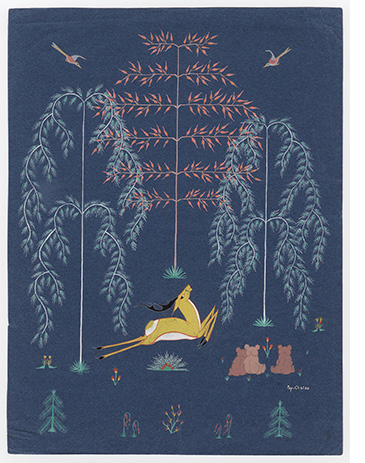Place, Nations, Generations, Beings
200 Years Of Indigenous North American Art
Yale University Art Gallery • New Haven, CT • artgallery.yale.edu • Through June 21, 2020

Place, Nations, Generations, Beings: 200 Years of Indigenous North American Art marks several significant firsts for the Yale University Art Gallery. Curated by three university students—Katherine Nova McCleary, Leah Tamar Shrestinian, and Joseph Zordan—over the past three years, the show inaugurates the museum’s premier showing of Indigenous North American art from over 40 nations. This exhibition also represents a milestone collaboration between three high-profile institutions—the Yale University Art Gallery, the Yale Peabody Museum of Natural History, and the Beinecke Rare Book and Manuscript Library. The selection of basketry, beadwork, drawings, photography, pottery, textiles, and wood carving on view date from the 19th century to today, presenting a diverse yet comprehensive survey of work.
The exhibition title outlines four broad themes that provide a framework for interpreting the impressive roster. “Place” explores the relationships between Indigenous peoples and their environments, while “Nations” probes how specific objects reflect the beliefs of various peoples. Artistic traditions, including how these practices are shared over time, form the organizing principle for “Generations,” and lastly, “Beings” encompasses connections between artists and other living organisms—not only animals and plants, but also creatures within the spiritual realm.
Throughout the show, the anonymous creators of multiple pieces are credited as “Artist Once Known,” with noteworthy, contemporary artists such as Marie Watt (Seneca) and Will Wilson (Diné [Navajo]) are featured prominently. A diptych by Watt—a large, textile-based wall hanging—takes the form of a mammoth set of wings with a bevy of colorful birds alongside other flying things such as UFOs, drones, and aircrafts. During sewing circles led by Watts, students and other community members embroidered the characters of First Teachers Balance the Universe, Part I: Things That Fly (Predator) and Part II: Things That Fly (Prey) (2015) on two found wool blankets. Together, they narrate an updated creation story of Sky Woman. According to the Seneca legend, the Iroquois mother goddess falls from a hole in the sky to Turtle Island, where animals nurtured her—underscoring the symbiosis between humans and the earth. Watts’s symbolic work echoes the meaningful and celebratory outcome of this momentous exhibition, honoring the lineage and relevance of indigenous artwork.
